Citroen C8 2013 1.G Owner's Manual
Manufacturer: CITROEN, Model Year: 2013, Model line: C8, Model: Citroen C8 2013 1.GPages: 234, PDF Size: 8.86 MB
Page 221 of 234
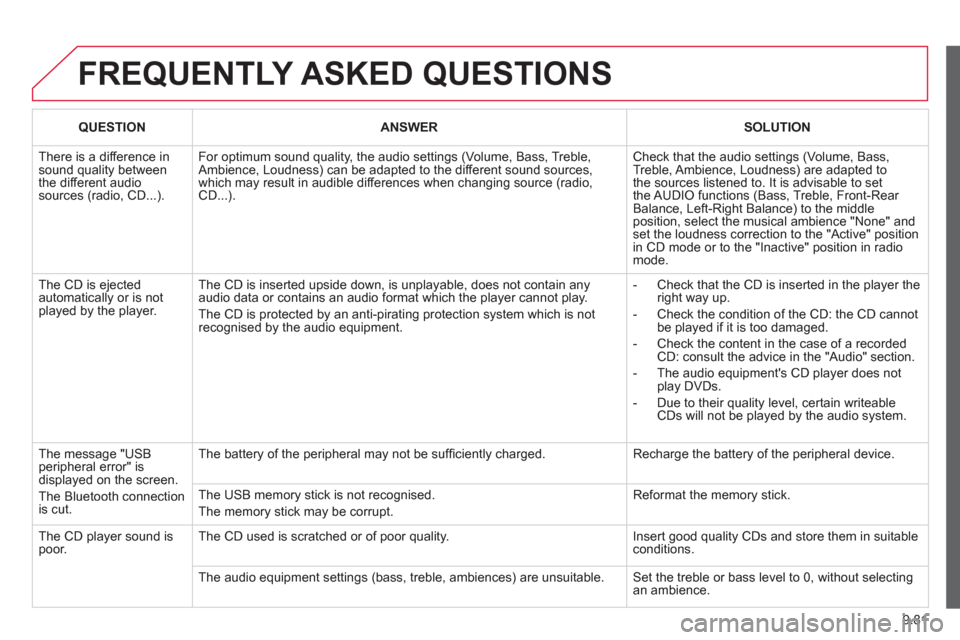
9.81
FREQUENTLY ASKED QUESTIONS
QUESTIONANSWERSOLUTION
There is a difference in sound quality betweenthe different audiosources (radio, CD...).
For optimum sound quality, the audio settings (Volume, Bass, Treble, Ambience, Loudness) can be adapted to the different sound sources,which may result in audible differences when changing source (radio,CD...).
Check that the audio settings (Volume, Bass, Treble, Ambience, Loudness) are adapted tothe sources listened to. It is advisable to setthe AUDIO functions (Bass, Treble, Front-Rear Balance, Left-Right Balance) to the middle position, select the musical ambience "None" and set the loudness correction to the "Active" position in CD mode or to the "Inactive" position in radio mode.
The CD is ejected automatically or is not played by the player.
The CD is inserted upside down, is unplayable, does not contain any audio data or contains an audio format which the player cannot play.
The CD is protected by an anti-pirating protection system which is not recognised by the audio equipment.
- Check that the CD is inserted in the player the right way up.
- Check the condition of the CD: the CD cannot be played if it is too damaged.
- Check the content in the case of a recordedCD: consult the advice in the "Audio" section.
- The audio equipment's CD player does notplay DVDs.
- Due to their quality level, certain writeableCDs will not be played by the audio system.
The message "USB peripheral error" isdisplayed on the screen.
The Bluetooth connectionis cut.
The battery of the peripheral may not be suffi ciently charged.
Recharge the battery of the peripheral device.
The USB memory stick is not recognised.
The memory stick may be corrupt.
Reformat the memory stick.
The CD player sound ispoor.The CD used is scratched or of poor quality.
Insert good quality CDs and store them in suitable conditions.
The audio equipment settings (bass, treble, ambiences) are unsuitable. Set the treble or bass level to 0, without selectingan ambience.
Page 222 of 234
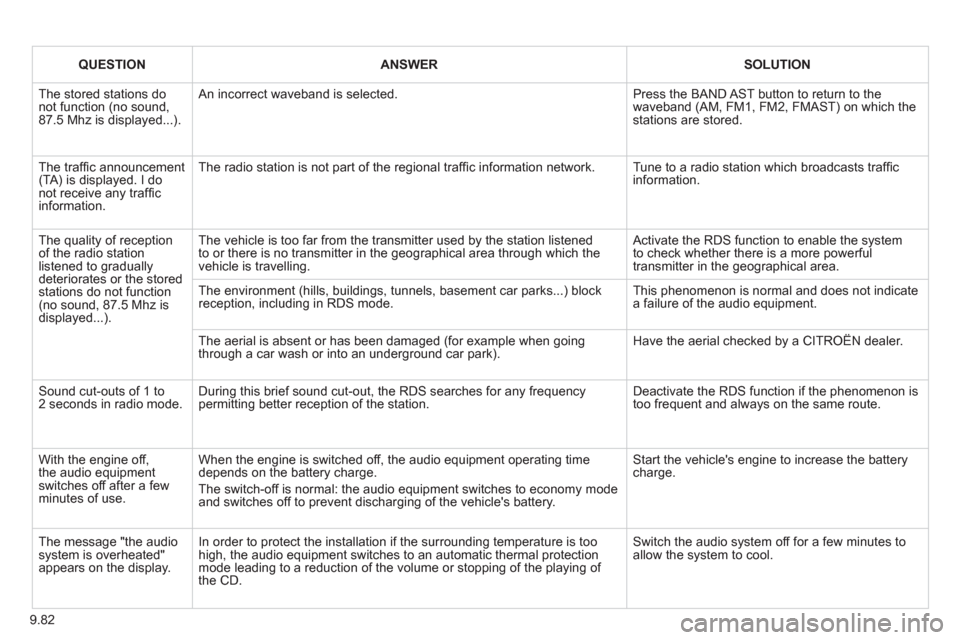
9.82
QUESTIONANSWERSOLUTION
The stored stations donot function (no sound, 87.5 Mhz is displayed...).
An incorrect waveband is selected.
Press the BAND AST button to return to the waveband (AM, FM1, FM2, FMAST) on which thestations are stored.
The traffi c announcement(TA) is displayed. I donot receive any traffi c information.
The radio station is not part of the regional traffi c information network.
Tune to a radio station which broadcasts traffi c information.
The quality of receptionof the radio station listened to graduallydeteriorates or the stored stations do not function(no sound, 87.5 Mhz is displayed...).
The vehicle is too far from the transmitter used by the station listenedto or there is no transmitter in the geographical area through which the vehicle is travelling.
Activate the RDS function to enable the system to check whether there is a more powerful transmitter in the geographical area.
The environment (hills, buildings, tunnels, basement car parks...) block reception, including in RDS mode. This phenomenon is normal and does not indicate a failure of the audio equipment.
The aerial is absent or has been damaged (for example when goingthrough a car wash or into an underground car park).
Have the aerial checked by a CITROËN dealer.
Sound cut-outs of 1 to2 seconds in radio mode.During this brief sound cut-out, the RDS searches for any frequency permitting better reception of the station.
Deactivate the RDS function if the phenomenon is too frequent and always on the same route.
With the engine off, the audio equipment switches off after a few minutes of use.
When the engine is switched off, the audio equipment operating timedepends on the battery charge.
The switch-off is normal: the audio equipment switches to economy mode and switches off to prevent discharging of the vehicle's battery.
Start the vehicle's engine to increase the batterycharge.
The message "the audio system is overheated" appears on the display.
In order to protect the installation if the surrounding temperature is toohigh, the audio equipment switches to an automatic thermal protectionmode leading to a reduction of the volume or stopping of the playing of the CD.
Switch the audio system off for a few minutes toallow the system to cool.
Page 223 of 234
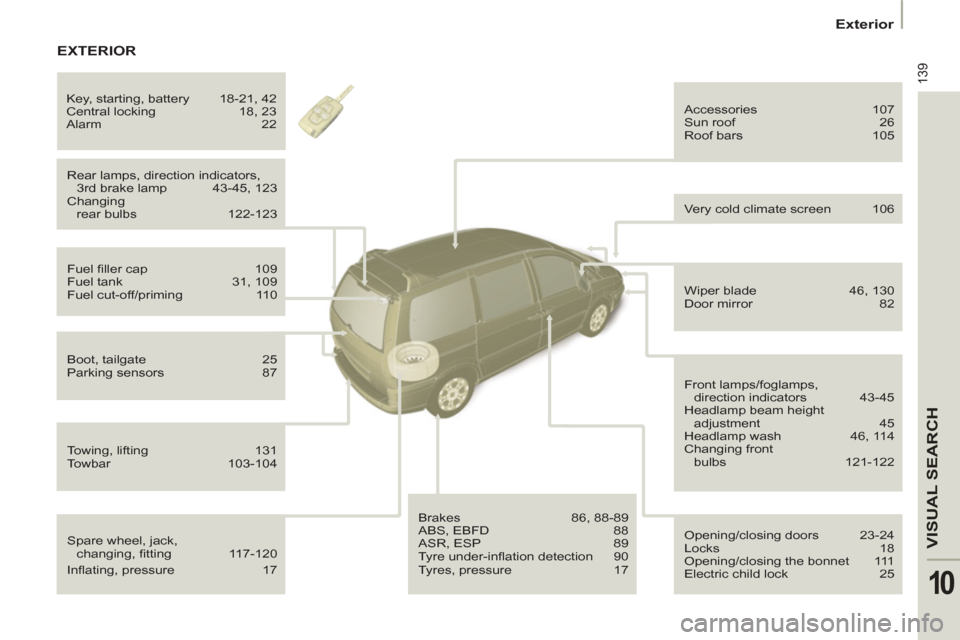
139
VISUAL SEARCH
10
Exterior
Rear lamps, direction indicators,
3rd brake lamp 43-45, 123
Changing
rear bulbs 122-123 Accessories 107
Sun roof 26
Roof bars 105
Fuel fi ller cap 109
Fuel tank 31, 109
Fuel cut-off/priming 110
Boot, tailgate 25
Parking sensors 87
Towing, lifting 131
Towbar 103-104
Spare wheel, jack,
changing, fi tting 117-120 Brakes 86, 88-89
ABS, EBFD 88
ASR, ESP 89
Tyre under-infl ation detection 90 Opening/closing doors 23-24
Locks 18
Opening/closing the bonnet 111
Electric child lock 25
Wiper blade 46, 130
Door mirror 82
Front lamps/foglamps,
direction indicators 43-45
Headlamp beam height
adjustment 45
Headlamp wash 46, 114
Changing front
bulbs 121-122 Very cold climate screen 106 Key, starting, battery 18-21, 42
Central locking 18, 23
Alarm 22
EXTERIOR
Infl ating, pressure 17 Tyres, pressure 17
Page 224 of 234
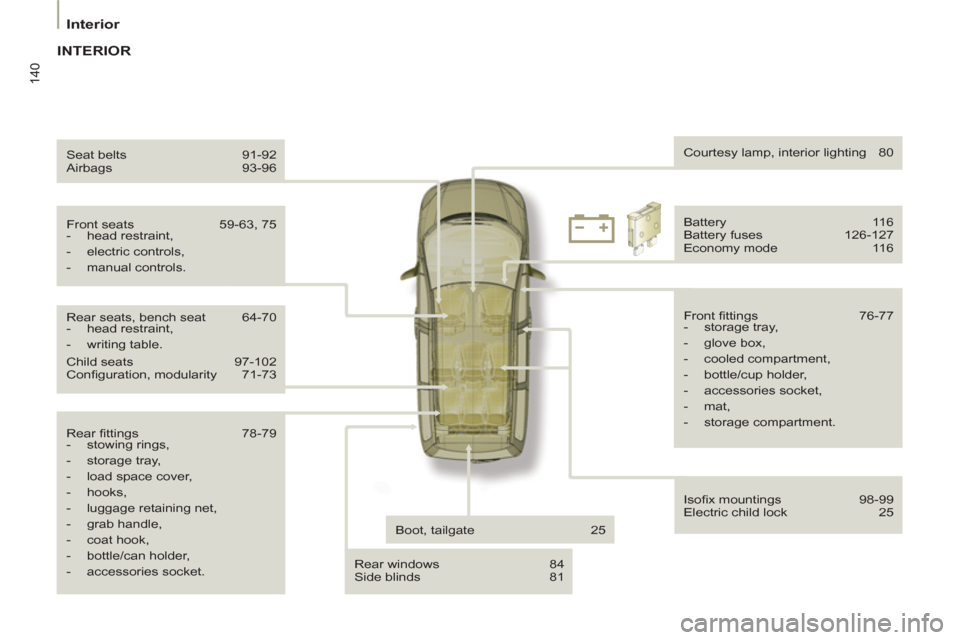
140
Interior
Rear fi ttings 78-79
- stowing rings,
- storage tray,
- load space cover,
- hooks,
- luggage retaining net,
- grab handle,
- coat hook,
- bottle/can holder,
- accessories socket. Boot, tailgate 25
Rear windows 84
Side blinds 81 Front seats 59-63, 75
- head restraint,
- electric controls,
- manual controls. Courtesy lamp, interior lighting 80
Seat belts 91-92
Airbags 93-96
Battery 116
Battery fuses 126-127
Economy mode 116
Front fi ttings 76-77
- storage tray,
- glove box,
- cooled compartment,
- bottle/cup holder,
- accessories socket,
- mat,
- storage compartment.
Isofi x mountings 98-99
Electric child lock 25
Rear seats, bench seat 64-70
- head restraint,
- writing table.
Child seats 97-102
Confi guration, modularity 71-73
INTERIOR
Page 225 of 234
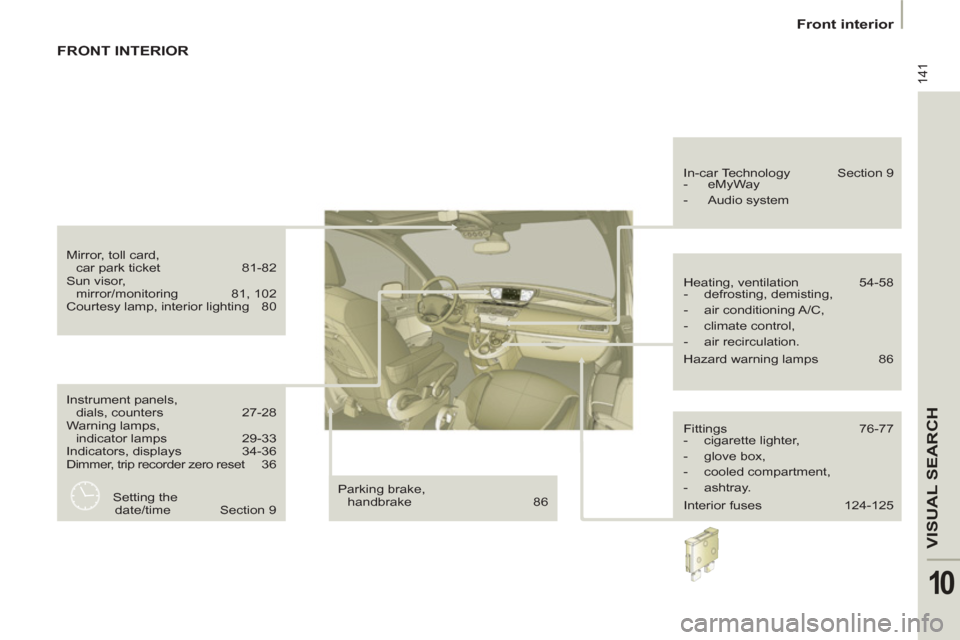
141
VISUAL SEARC
H
10
Front interior
Instrument panels,
dials, counters 27-28
Warning lamps,
indicator lamps 29-33
Indicators, displays 34-36
Dimmer, trip recorder zero reset 36
Parking brake,
handbrake 86 Heating, ventilation 54-58
- defrosting, demisting,
- air conditioning A/C,
- climate control,
- air recirculation.
Hazard warning lamps 86 In-car Technology Section 9
- eMyWay
- Audio system
Fittings 76-77
- cigarette lighter,
- glove box,
- cooled compartment,
- ashtray.
Interior fuses 124-125
Mirror, toll card,
car park ticket 81-82
Sun visor,
mirror/monitoring 81, 102
Courtesy lamp, interior lighting 80
Setting the
date/time Section 9
FRONT INTERIOR
Page 226 of 234
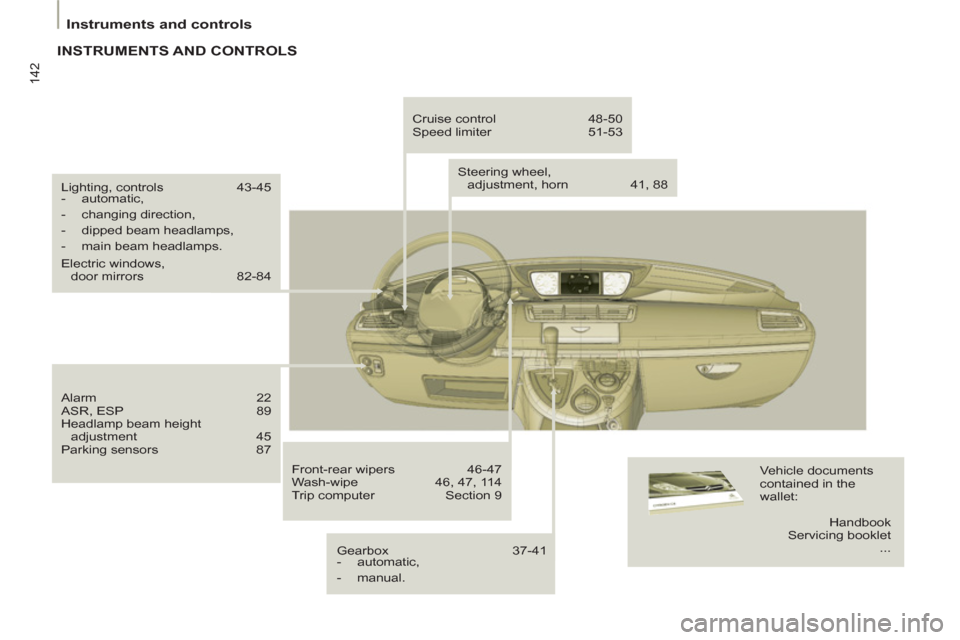
142
Instruments and controls
Lighting, controls 43-45
- automatic,
- changing direction,
- dipped beam headlamps,
- main beam headlamps.
Electric windows,
door mirrors 82-84
Alarm 22
ASR, ESP 89
Headlamp beam height
adjustment 45
Parking sensors 87 Cruise control 48-50
Speed limiter 51-53
Steering wheel,
adjustment, horn 41, 88
Front-rear wipers 46-47
Wash-wipe 46, 47, 114
Trip computer Section 9
Gearbox 37-41
- automatic,
- manual.
Vehicle documents
contained in the
wallet:
Handbook
Servicing booklet
...
INSTRUMENTS AND CONTROLS
Page 227 of 234
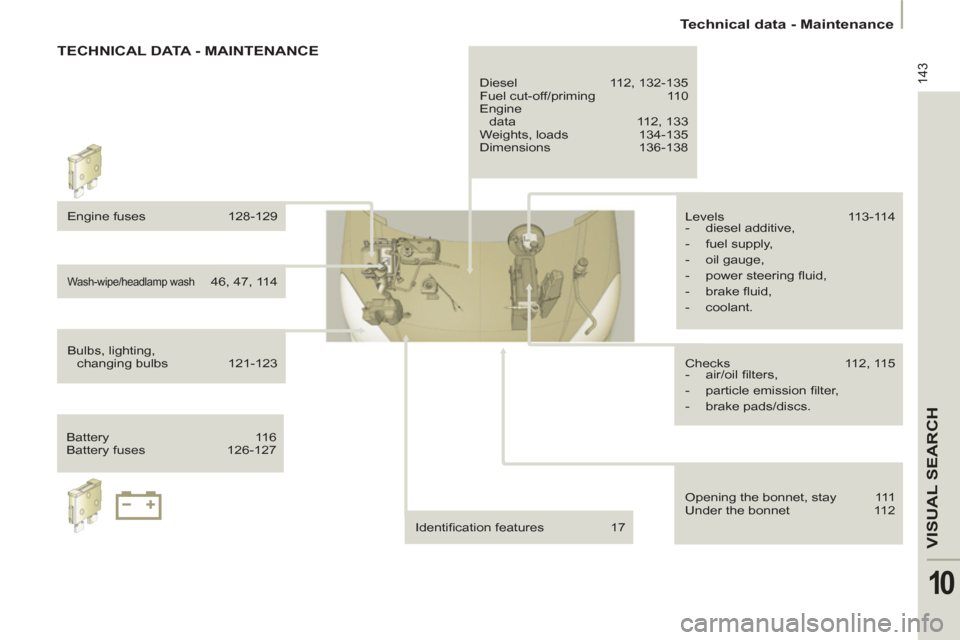
143
VISUAL SEARC
H
10
Technical data - Maintenance
TECHNICAL DATA - MAINTENANCE
Engine fuses 128-129
Wash-wipe/headlamp wash 46, 47, 114
Bulbs, lighting,
changing bulbs 121-123
Battery 116
Battery fuses 126-127 Checks 112, 115
- air/oil fi lters,
- particle emission fi lter,
- brake pads/discs. Levels 113-114
- diesel additive,
- fuel supply,
- oil gauge,
- power steering fl uid,
- brake fl uid,
- coolant. Diesel 112, 132-135
Fuel cut-off/priming 110
Engine
data 112, 133
Weights, loads 134-135
Dimensions 136-138
Identifi cation features 17 Opening the bonnet, stay 111
Under the bonnet 112
Page 228 of 234
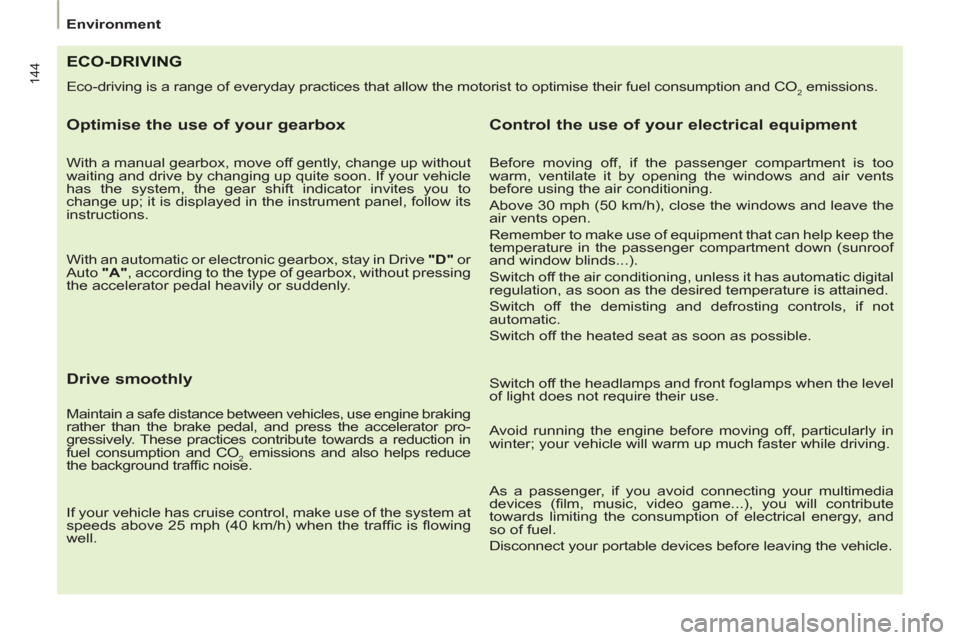
144
Environment
ECO-DRIVING
Eco-driving is a range of everyday practices that allow the motorist to optimise their fuel consumption and CO2 emissions.
Optimise the use of your gearbox
With a manual gearbox, move off gently, change up without
waiting and drive by changing up quite soon. If your vehicle
has the system, the gear shift indicator invites you to
change up; it is displayed in the instrument panel, follow its
instructions.
With an automatic or electronic gearbox, stay in Drive "D"
or
Auto "A"
, according to the type of gearbox, without pressing
the accelerator pedal heavily or suddenly.
Drive smoothly
Maintain a safe distance between vehicles, use engine braking
rather than the brake pedal, and press the accelerator pro-
gressively. These practices contribute towards a reduction in
fuel consumption and CO
2 emissions and also helps reduce
the background traffi c noise.
If your vehicle has cruise control, make use of the system at
speeds above 25 mph (40 km/h) when the traffi c is fl owing
well.
Control the use of your electrical equipment
Before moving off, if the passenger compartment is too
warm, ventilate it by opening the windows and air vents
before using the air conditioning.
Above 30 mph (50 km/h), close the windows and leave the
air vents open.
Remember to make use of equipment that can help keep the
temperature in the passenger compartment down (sunroof
and window blinds...).
Switch off the air conditioning, unless it has automatic digital
regulation, as soon as the desired temperature is attained.
Switch off the demisting and defrosting controls, if not
automatic.
Switch off the heated seat as soon as possible.
Switch off the headlamps and front foglamps when the level
of light does not require their use.
Avoid running the engine before moving off, particularly in
winter; your vehicle will warm up much faster while driving.
As a passenger, if you avoid connecting your multimedia
devices (fi lm, music, video game...), you will contribute
towards limiting the consumption of electrical energy, and
so of fuel.
Disconnect your portable devices before leaving the vehicle.
Page 229 of 234
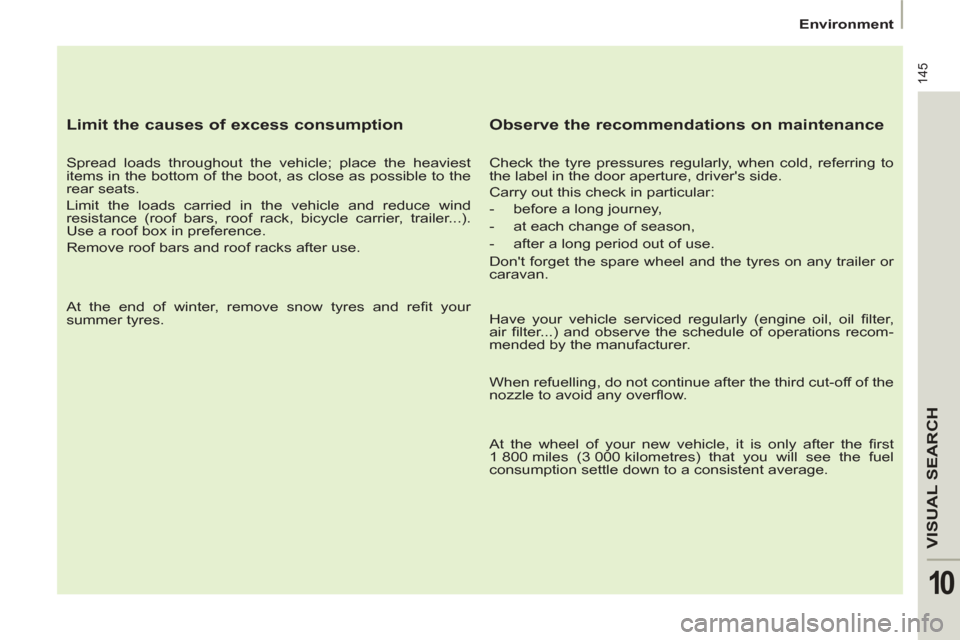
145
VISUAL SEARC
H
10
Environment
Limit the causes of excess consumption
Spread loads throughout the vehicle; place the heaviest
items in the bottom of the boot, as close as possible to the
rear seats.
Limit the loads carried in the vehicle and reduce wind
resistance (roof bars, roof rack, bicycle carrier, trailer...).
Use a roof box in preference.
Remove roof bars and roof racks after use.
At the end of winter, remove snow tyres and refi t your
summer tyres.
Observe the recommendations on maintenance
Check the tyre pressures regularly, when cold, referring to
the label in the door aperture, driver's side.
Carry out this check in particular:
- before a long journey,
- at each change of season,
- after a long period out of use.
Don't forget the spare wheel and the tyres on any trailer or
caravan.
Have your vehicle serviced regularly (engine oil, oil fi lter,
air fi lter...) and observe the schedule of operations recom-
mended by the manufacturer.
When refuelling, do not continue after the third cut-off of the
nozzle to avoid any overfl ow.
At the wheel of your new vehicle, it is only after the fi rst
1 800 miles (3 000 kilometres) that you will see the fuel
consumption settle down to a consistent average.
Page 230 of 234
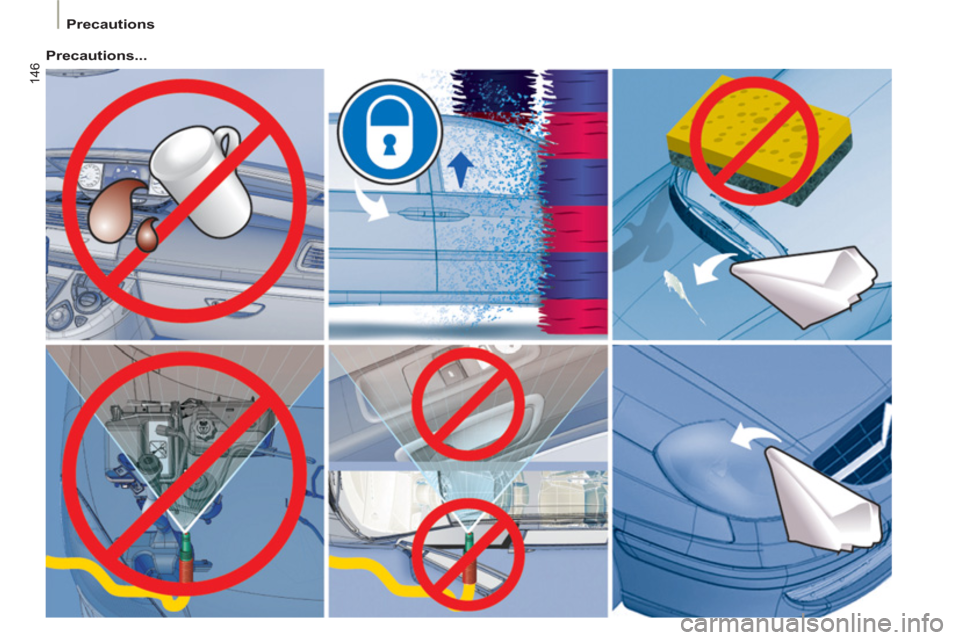
146
Precautions
Precautions...